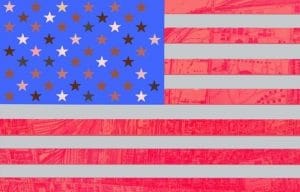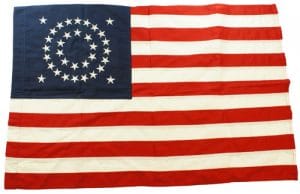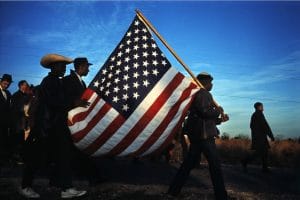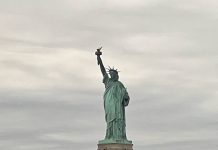
Macy Gray’s proposal for a new American flag is not an isolated incident or a statement severable from the ethos of our time. Instead, it is emblematic of the slow dismantling of the traditional American identity. In its insidious wreckage will be two Americas.
One, based on the ideals of personal freedom and individual responsibility as encapsulated in the Declaration of Independence and the U.S. Constitution, with philosophical roots in the Enlightenment and Classical Liberalism and economic ties to the free market; the other defined by the march for broader freedoms and inclusivity, with an acute sense of justice, and its economic basis in Neo-Marxism and theoretical underpinnings in Postmodernism.
The Irony of the American Flag
Still, it’s ironic that the same chorus of voices that called for Juneteenth to be a federal holiday (I think it should have been a Harriet Tubman day instead) are simultaneously clamoring for the dissolution of the current flag. Why do I say it’s ironic? Because when U.S. General Gordon Granger stood on the island of Galveston, Texas, and read aloud General Orders No. 3:which reiterated the Emancipation Proclamation issued 2.5 years earlier, he carried the 35-star flag, with its traditional red, white, and blue design.

I will not dismiss Ms. Gray’s pronouncement as unfounded and divisive. She is an American, and deserves to have her voice heard, which is in line with why freedom of speech is the first amendment to our constitution. The singer is also correct in pointing out the historic injustices that were perpetrated on people of color while our current flag, and the iterations before it, flew over our capital, our schools, and other government buildings as well as private residences. Her statement that our current flag is “tattered, dated, divisive, and incorrect” and claiming that “it no longer represents democracy and freedom,” however, may be missing the point, and in doing so, hammering on the fracture lines of American society.
The history of flags in the United States is problematic. To begin with, the Confederate flag is fraught with controversy and tied to those who defended, if not the institution of slavery and its inherent origins in racism, the way of life and the claims of state’s rights that ultimately protected its validity.
And, though there has been a slow purging of this emblem from state capitols, (a move I support), even our fairly recent military history has connections to this contentious banner. The Atlantic article Why the Confederate Flag Flew During World War II provides this example: “As American forces took over Pacific Islands or European towns, the troops would sometimes raise the Confederate flag alongside or instead of the U.S. flag to celebrate their victory. The Baltimore Evening Sun described this as a ‘recurring phenomenon which has been observed in areas as widely separated as the Southwest Pacific, Italy and France.’”
The History of Flags in America is Complicated
But like most issues we struggle with, it’s more complicated than that narrative. After General Sherman’s march to the sea and the ensuing conflagration of Confederate states towards the end of the American Civil War, the Connecticut-born abolitionist Reverend Henry Ward Beecher unfurled the Union flag in South Carolina, which had been particularly devastated, and proclaimed:
Let no man misread the meaning of this unfolding flag! It says, ‘government hath returned hither.’ It proclaims in the name of vindicated government, peace and protection to loyalty; humiliations and pains to traitors. This is the flag of sovereignty. The nation, not the States, is sovereign. Restored to authority, this flag commands, not supplicates . . . . There may be pardon [for former Confederates], but no concession . . . . The only condition of submission is to submit!
All through the Confederate south, the Confederate flag was removed and replaced by the Union flag, the forerunner of our contemporary flag. Nearly one third of a million union soldiers, including all-black units, gave their lives fighting under the Stars and Stripes in this horrible war which not only pitted competing ideologies, but brothers against each other. And though not all Union soldiers and military leaders were concerned about demolishing the “peculiar institution,” many were. Here are some diary excerpts from Union soldiers:
- As sure as God is God and right is right, so sure may we look for the war to end . . . in the accomplishment of its glorious object, . . . the liberation of this oppressed and down trodden race . . . I would prefer ten years war yet and no more slavery, than Peace tomorrow, with slavery. Such is my abhorance of that Barbarous institution. (Sgt James Jessee, Eighth Illinois, diary entry, December 31, 1863.)
- … As long as we ignore the fact (practically) that Slavery is the basis of this struggle so long are we simply [cutting] down a vigorously growing plant that will continually spring up and give new trouble at very short intervals. We must emancipate.” (Q.M. Sgt. Thomas Low, 23rd New York Artillery, diary entry, March 29, 1862.)
- … The rebellion is abolitionizing the whole army… [time spent in the South has forced Union troops] “to face this sum of all evils, and cause of the war… You have no idea of the changes that have taken place in the minds of the soldiers in the last two months… men of all parties seem unanimous in the belief that to permanently establish the Union, is to first wipe [out] the institution [of slavery].” (Enlisted Soldier,” Third Wisconsin, quoted in the Wisconsin State Journal, October 1861.)
The Tuskegee Airman and the American Flag
The same is true of The Tuskegee Airmen, a group of primarily black pilots, bombardiers, and airplane mechanics who distinguished themselves as one of the most skilled and decorated groups of men to fight for the United States during World War II.
Their heroics are the stuff of legends, accomplishing feats of bravery most thought were impossible. In an interview with journalist Studs Terkel, Tuskegee Airman Coleman Young, later the first African-American mayor of Detroit, had this to say about his experiences:
They made the standards so high, we actually became an elite group. We were screened and super-screened. We were unquestionably the brightest and most physically fit young blacks in the country. We were super-better because of the irrational laws of Jim Crow. You can’t bring that many intelligent young people together and train ’em as fighting men and expect them to supinely roll over when you try to fuck over ’em, right?
Consider the following words from General Benjamin O. Davis, a black United States Air Force general and commander of the World War II Tuskegee Airmen: “The privileges of being an American belong to those brave enough to fight for them.” Davis was far from a simpleton who wrapped himself in Old Glory while ignoring the entrenched bigotry that surrounded him.

A recent article about Davis from the Public Service Institute sheds some light on the deep character that imbued Davis: “Yet, in spite of, or rather, because of the hardships he endured, Davis had already made an impact on his future fellow officers. In the 1936 issue of The Howitzer, West Point’s yearbook, it was said of him: ‘The courage, tenacity, and intelligence with which he conquered a problem incomparably more difficult than plebe year won for him the sincere admiration of his classmates, and his single-minded determination to continue in his chosen career cannot fail to inspire respect wherever fortune may lead him.’”
Ultimately, Davis did not seek to undo the American Dream, but to have it woven into the quilt of our history and future.
And make no mistake about it. What the Tuskegee Airmen accomplished is nothing short of magic. Not only did they endure the active oppression of the racism of their time, they transmogrified the symbolism of Tuskegee, ever stained by the heinous Tuskegee Study, into a symbol of pride and redemption of the American thirst for progress and change. And they did this in an effort not to dismantle the entirety of the American system, but to insist upon full participation in its imperfect, yet promising future, a future they vociferously asserted include everyone. As President John Fitzgerald Kennedy said, “There are no ‘white’ or ‘coloured’ signs on the foxholes or graveyards of battle.”
Martin Luther King, Jr. and the American Flag
Approximately two decades later, Martin Luther King, Jr., an icon of the Civil Rights Movement, led thousands of protestors in marches, demanding not to overturn the American Dream, but to insist on being part of it. And Americans of all colors and ethnicities recoiled in horror as they watched footage of the violence perpetrated on peaceful protestors as they were beaten down by law enforcement with clubs, poisoned with tear gas, and pummeled by fists in the well-known Selma to Montgomery march. And if you looked closely, the U.S. flag was carried proudly and featured prominently by the protestors in this event.

King’s connection to the American flag became edified, ironically, by his assassination. In honor of Dr. King, a flag was raised over the United States Capitol on April 4, 1968, at the request of New York Congressman Henry P. Smith III. From there, Smith then arranged for the flag to be flown over the cemetery in Pekin, New York, which had been an important stop on the Underground Railroad for slaves trying to reach safety in Canada.
Then, according to the Anderson University (AU) website, this flag was donated to the university by Mr. Everett Humphrey, an AU alumni who acquired the flag and wanted to honor the memory of the civil rights leader who paid the ultimate sacrifice. According to Humphrey, this historical flag serves as a “witness” to the assassination — “one of the greatest tragedies of the twentieth century.”
President Obama and the American Flag
And to mark the observance of the tragedy and ultimate triumph of Selma, President Obama had the following words:
The American instinct that led these young men and women to pick up the torch and cross this bridge is the same instinct that moved patriots to choose revolution over tyranny. It’s the same instinct that drew immigrants from across oceans and the Rio Grande; the same instinct that led women to reach for the ballot and workers to organize against an unjust status quo; the same instinct that led us to plant a flag at Iwo Jima and on the surface of the Moon.
The American Flag and Our Future
Our country is flawed. We have much to work on. And try as we might, we struggle to escape the sins of our collective past. Yet, the way forward is not to tear apart the warp and weft of the past, but to integrate its better parts into the present. We don’t need a new flag, we need to make sure our current flag lives up to the hope and change President Obama spoke about.
We, as a nation, are a work in continual progress. Our flag may indeed be “tattered,” but we as a people need not be. We share a common history, one that is simultaneously frightening in its depths of depravity and oppression, and inspiring in its story of sacrifice in the victory over adversity. Somewhere in between the naivety of the Enlightenment and the cynicism of Marxism, lies a vast space for communion, a place where we acknowledge the past, but don’t destroy it, a place where the future does not cleave us along racial lines and balkanize our ideas, but seeks to focus on how we are alike.
We still have work to do. But we have to do it together, and proffering the idea of doing away with the American flag is a slap in the face to all that have gone before, all who have sacrificed their welfare and their lives, all who endeavored to extend the American Dream to those who had previously been denied it. As July 4th approaches, let’s not shatter the symbol of the dream, let us instead, in the words of Langston Huhges, make sure it is no longer “deferred.”
At Newsweed.com, we adhere to three simple principles: truth, balance, and relatability. Our articles, podcasts, and videos strive to present content in an accurate, fair, yet compelling and timely manner. We avoid pushing personal or ideological agendas because our only agenda is creating quality content for our audience, whom we are here to serve. That is why our motto is ”Rolling with the times, straining for the truth.”
Your opinion matters. Please share your thoughts in our survey so that Newsweed can better serve you.
Charles Bukowski, the Los Angeles beat poet that captured the depravity of American urban life once said, “There is something about writing poetry that brings a man close to the cliff’s edge.”
Newsweed is proud to stand in solidarity and offer you a chance to get close to the cliff’s edge with our first Power of Poetry Contest. Are you a budding bard, a versatile versifier, a rhyming regaler? Do you march to the beat of iambic pentameter, or flow like a river with free verse? If so, here’s your opportunity to put your mad poetic chops to the test. Enter our poetry contest for bragging rights and an opportunity to win some cash!






